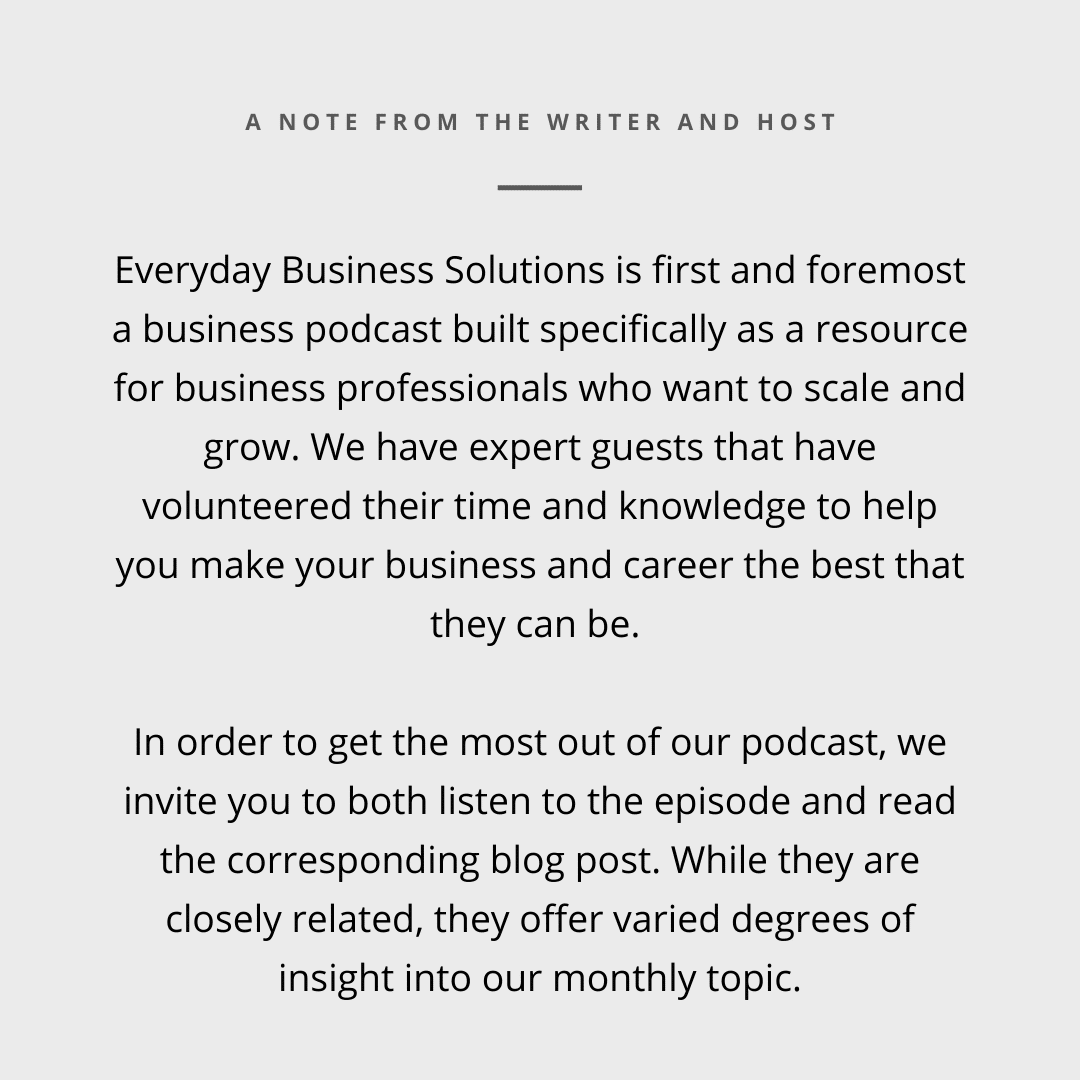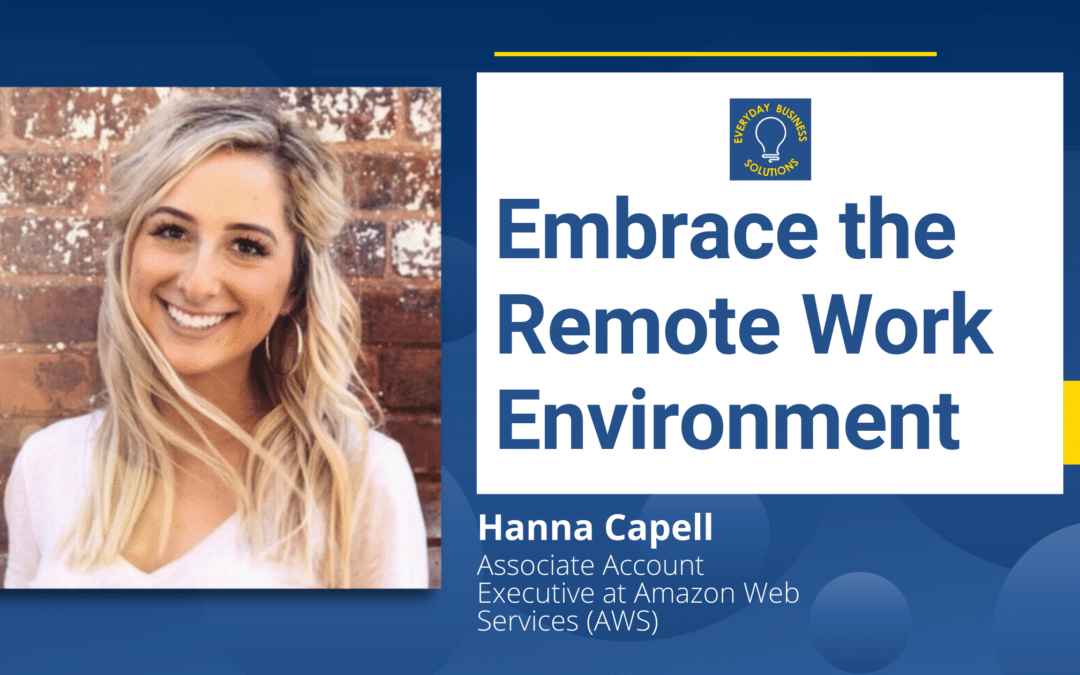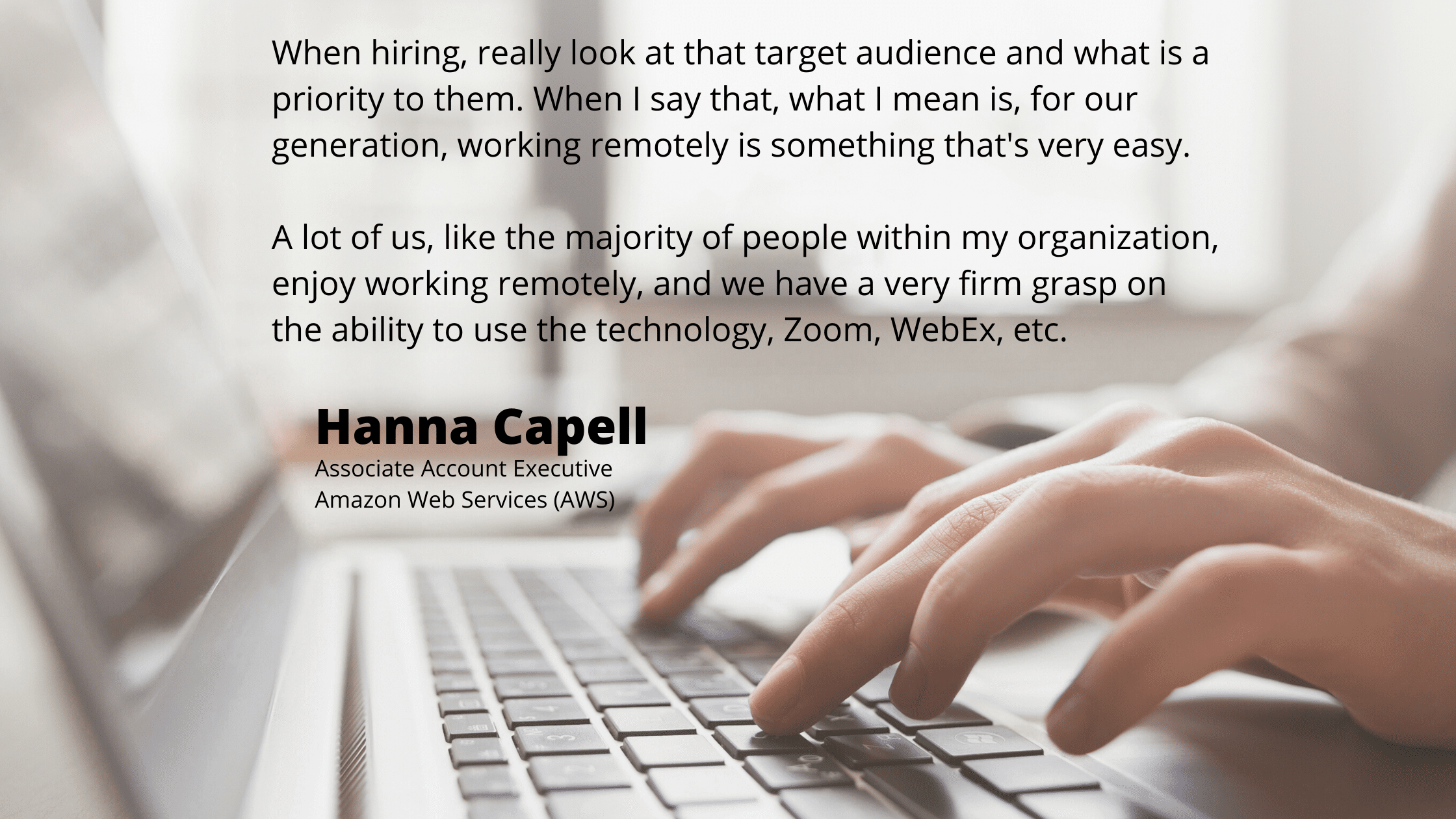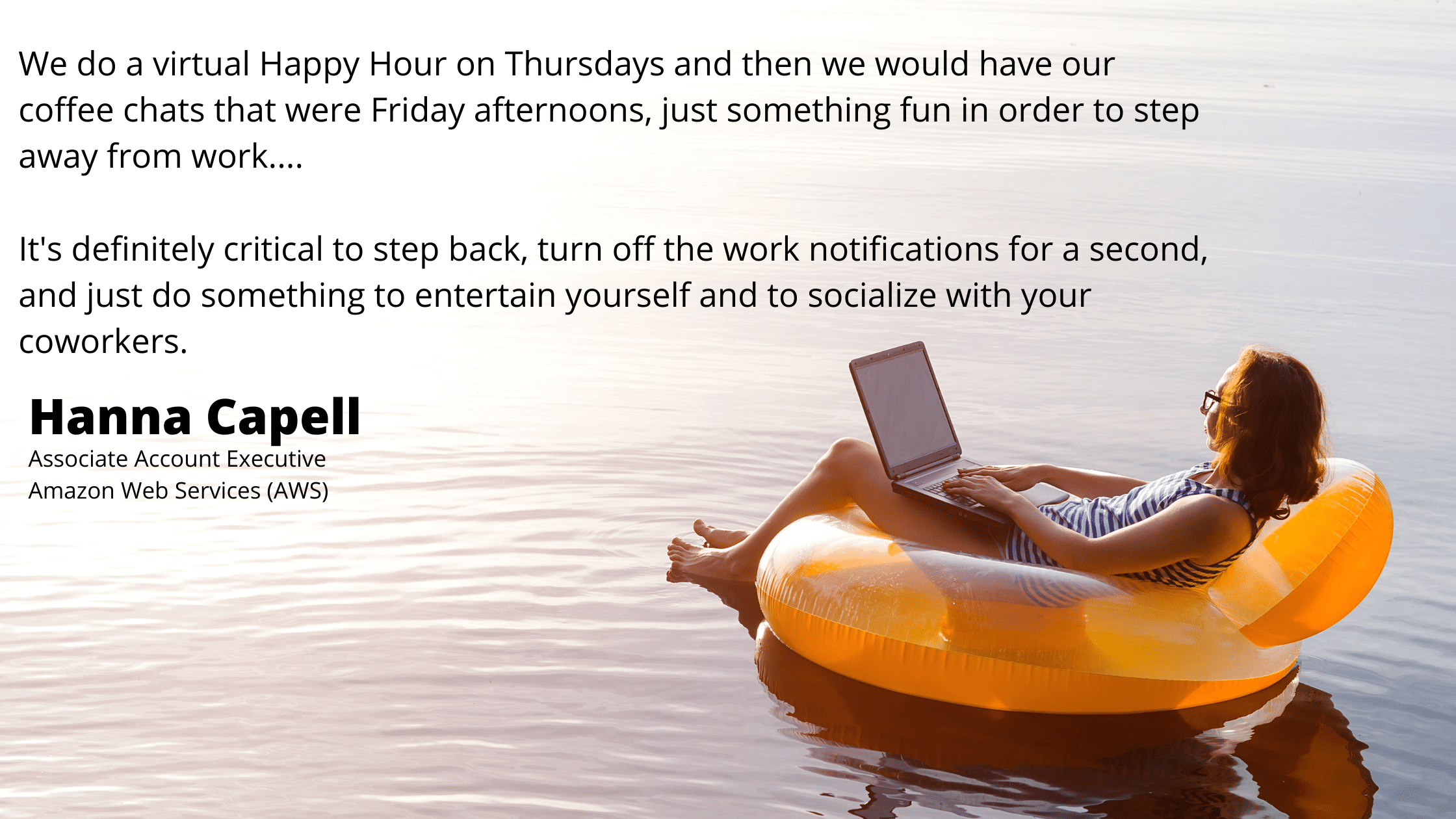Audio Version
Podcast Transcription
Video Version
More and more employers are considering remote and hybrid environments, so I sat down with Hanna Capell from Amazon Web Services to talk about what it’s like working remotely and how she manages her work-life balance.
The Big Pivot to Remote
For many, the mad rush to shift business to a fully remote setting was upsetting and disruptive, especially because most thought that it would be a very brief break in routine and then we’d all go back to the way things were.
However, as we creep up on the second anniversary since the Great Shutdown it’s important to note that the shift to a more remote work environment seems to have stuck around in places. The reason? It makes sense and people like having the ability to work from home or on the go.


How Employees are Adapting
To put it simply, employees are not just adapting to remote work better than business leaders thought, but many are pushing for it.
I’ll preface this by saying that everyone is different and some employees prefer an active in-office environment. We are a very social species after all.
However, remote work environments are empowering. They allow people to take jobs in cities different than they live in and to control the physical elements they work in. Employees feel comfortable taking short breaks when they’re burnt out or changing their environment when they feel they’ve hit a mental roadblock.
Not to mention that now they don’t have to foot the cost of gas to travel to work and maybe are eating out a lot less.
While many initially struggled with the shift, most have adapted and can comfortably manage to work remotely. Many have even increased their productivity as they’re more satisfied with their working conditions.
Is it Smart to Shift Back?
The short answer is “it depends” and it really does. It does depend on the type of work you’re doing and you may not have been able to go remote in the first place. Mostly it depends on your teams and the individuals. What works for one is not what works for everyone.
61 percent of employees prefer being fully remote and 97 percent don’t want to return to the office full-time, according to Forbes.
“We want to be able to collaborate,” Corporate says as they shift their entire workforce back into the old routine in the old office. “This way we can talk face to face,” but employees are already collaborating and bonding. They’ve likely even expanded their networks beyond well beyond their physical reach.
Forcing employees back into the office full-time when it’s not necessary is going to cause many to leave. Collaborating in person is no longer a justification team members will accept. While they may not outright tell you, their two-week notice a few months later will.
It’s been dubbed the Great Resignation by some on LinkedIn and what it represents is a shifting workforce. Jenna Smith, a previous guest on the Everyday Business Solutions podcast and great business consultant, shared a post talking about how people are looking for people-first organizations and if they don’t have it, they leave.
So is it smart to shift back to a fully in-office workforce? Probably not. More than likely it’s time to adopt a hybrid work environment and give each team member the choice. There are even many successful companies already adopting this business model.
The Cost of “One Size Fits All”
People have been plagued by this concept of “one size fits” all in clothing stores for too long (please just stop), but the truth is that it seems to have been ingrained in business for even longer.
People built themselves up to have the necessary skill set for a particular job in a particular company. They dressed exactly to dress code, went to work, plugged themselves into the routine, and went home, just to do it again the next day. They’d even stay in that job for a decade if not more.
Now people look for jobs that they enjoy, fit their existing skillset, and are in line with their interests and beliefs.
Companies have to consider each team member and how to make the work environment as flexible and personal as possible. The cost if they don’t? Their employees will leave at the first promising opportunity that comes their way, passively looking during lunch hours and after work for something else before that.
Tips to Sustain a Hybrid Workforce
Given the current climate, it’s not absurd to think that many businesses will shift to a fully established hybrid business model over the next few years. So here are a few tips to help you build a sustainable model:
- Don’t cut the pay of your remote workers – Applicants are now discovering that their offers are smaller if they’re applying for a remote position. The justification? They don’t have to commute. However, you’re now saving money by not paying overhead to have that team member in the office and they have to foot the bill on wifi and electricity to work from home. They know this and employees do talk pay, so don’t plan on shorting anyone just because they will be working remotely.
- Give existing employees the choice – If you weren’t doing hybrid before or offering remote work to local team members, then offer current team members a choice between remote work and in-person. Don’t decide for them. If they were applying for jobs at this moment, they might not even apply to an in-person job. So if you make them come in against their will, you’re only encouraging them to job search for someone who will give them the option.
- Don’t be THAT employer – I’m talking about the one who went viral on socials for forcing all team members to keep their webcams on for their entire remote workday. Those employees eventually left them. No matter what your remote status is, micromanagement is not okay. You’re working with adults and if you can’t trust your team, ask yourself why you hired people you can’t trust or why your team started hiding things from you. The problem is usually, again, with management.
- Encourage your team leaders to host social sessions – Virtual social sessions, whether over a cheesy game or a drink, with no expectation of work is a great way to help your teams bond no matter where they are. If your employees get along better in a casual setting, they feel much more comfortable working together. It also makes them feel more included while destressing at the same time.
- Check-in – Some team members aren’t social butterflies and that’s okay, but make sure to reach out to everyone and see how they’re doing. Catch up on how they’re handling the workload, if they’re satisfied, and anything else that can affect that morale.
- Don’t expect remote employees to work in one spot – Your team member is remote. If they want to fly to Maine for the weekend and work from an Airbnb overlooking the Atlantic, that’s their choice. Not yours. As long as they perform their work within professional bounds, they’re still doing their job. They chose a remote job for a reason. For many, it’s because of the flexibility to work literally wherever they want.
- Don’t make exceptions to the rules just to retain someone – For some companies, a hybrid work environment means teams of strictly remote or strictly in-person employees. You don’t have to have hybrid employees if it doesn’t make sense for your business (though don’t immediately discount the idea). However, if you say no to partially remote team members, then stick by it. Don’t let higher-performing team members or managers break that rule just to retain them. It builds resentment amongst everyone else.
The biggest thing you should understand from both my conversation with Hanna and from this blog is that employees want to be heard and respected. Your culture and success come from your team so prioritize nurturing that relationship.
About Our Guest:

Hanna Capell
Start-Up Associate Account Executive at Amazon Web Services (AWS)
Hanna Capell graduated from college in December of 2020 and jumped straight into a position as an Associate Account Executive at Amazon Web Services (AWS) based out Seattle Washington. The catch? She would have to work remotely from the start and the temporary arrangement is quickly dragging into a full year of her employment.
However, working remotely hasn’t been a negative experience for her. In fact, she’s enjoyed the experience a lot, preferring it to be in-office, and she’s not the only one. Many employees across the globe have found remote work to be a more desirable alternative to returning to their offices. In my conversation with Hanna we broke down her experiences so far and some things employers should consider moving forward.
Enjoy Listening To How To Have A Proper Work Life Balance on Everyday Business Solutions?
Click Here To Subscribe On Your Favorite Platform!



